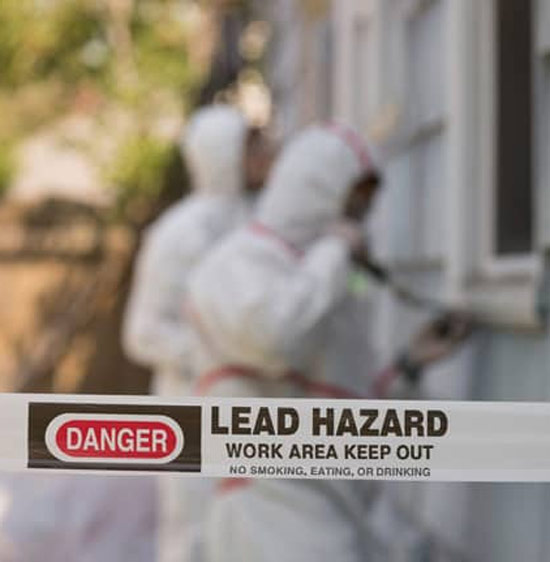Lead Paint Removal Service-- NYC's Trusted Solutions for Lead Safety
Lead Paint Removal Service-- NYC's Trusted Solutions for Lead Safety
Blog Article
Vital Tools and Techniques for Effective Lead Violation Cleanup
Attending to lead offenses effectively demands a thorough strategy that mixes the right devices with critical techniques. The primary step involves outfitting employees with Individual Safety Devices (PPE) to protect their health. Simultaneously, using specialized clean-up tools, such as HEPA vacuums and lead-specific cleaning representatives, is necessary for complete pollutant elimination. Efficient control techniques, including plastic sheeting and adverse air pressure systems, are vital to protect against the spread of harmful materials. In addition, risk-free disposal practices and rigorous adherence to regulatory standards guarantee liable handling of hazardous waste. Yet what are the nuanced techniques that absolutely make a difference?
Personal Protective Tools
Personal protective tools (PPE) is a crucial element in the effective monitoring of lead contamination cleanup. The important PPE for lead cleanup includes respirators, protective apparel, handwear covers, and eye defense.
Respirators, specifically those furnished with HEPA filters, are vital for filtering system air-borne lead particles, preventing breathing. Correct fit and seal checks are vital to ensure their performance. Safety garments, including coveralls and disposable matches, stops lead dust from sticking to employees' garments, reducing the threat of additional contamination. Gloves, commonly made from nitrile or latex, secure the skin from direct call with lead, while safety and security goggles or full-face guards safeguard the eyes from dirt and debris.
In addition, rigorous training on the proper usage and upkeep of PPE is vital. Employees should be enlightened on putting on and doffing treatments to avoid contamination. Normal inspections and substitutes of PPE parts are required to keep their protective abilities, making certain a risk-free and certified cleanup procedure.
Specialized Clean-up Equipment

One more crucial tool is the wet/dry vacuum, which can properly tidy up both dust and fluid contaminants. These vacuums commonly feature HEPA filters to provide an extra layer of safety and security. Damp wipes or tack fabrics are likewise critical for surface cleaning; they are particularly created to record and hold lead particles, decreasing the risk of spreading out contamination.
For more stubborn deposits, specialized lead-removal cleaning agents are called for. These representatives are created to damage down lead particles, making them easier to remove. Scrub brushes with durable bristles can assist in this process, specifically on rough surface areas where lead dust tends to adhere much more highly.
Furthermore, encapsulants are made check these guys out use of to secure lead-contaminated surface areas, stopping the launch of lead dust. These specialized paints and finishings are developed to adhere to various substrates, providing a long-term solution for lead containment.
Reliable Control Methods
Effective control approaches are vital in mitigating the spread of lead contamination throughout clean-up tasks. Carrying out robust control techniques ensures that lead fragments do not migrate to untouched areas, therefore securing both workers and the atmosphere (DOH & HPD Lead Violation Removal NYC).

To boost control, encapsulants can be applied to surface areas that are not being gotten rid of or disturbed. These specialized layers bind lead dirt, decreasing its availability for resuspension. Furthermore, all workers need to use appropriate Personal Safety Tools (PPE), including respirators and non reusable matches, to avoid contamination spread.
Safe Disposal Practices
Guaranteeing safe disposal practices is a critical element in the administration of lead contamination cleanup. Correct disposal reduces the threat of lead returning to the environment and jeopardizing public health (DOH & HPD Lead Violation Removal NYC).
Delivering lead waste requires adherence to strict guidelines. Making use of certified contaminated materials carriers ensures that the products are dealt with properly. Documents, including materializes outlining the type and quantity of waste, must go along with deliveries to track the waste from the site of beginning to its final disposal location.
Designated contaminated materials disposal facilities are furnished to handle lead-contaminated products securely. These centers often utilize innovative methods such as stablizing, solidification, or chemical treatment to reduce the effects of the lead prior to disposal. Landfilling in specialized, lined areas that prevent leachate from infecting groundwater is a common method for last disposal.
Normal training Look At This for personnel included in lead waste disposal is crucial to maintain security standards and avoid unexpected direct exposure. By adhering to these techniques, organizations can considerably lower the environmental and wellness impacts associated with lead contamination.
Regulatory Conformity Tips

Sticking to regulatory conformity is vital in the effective implementation of lead contamination cleanup. Recognizing and following federal, state, and local visit this site laws makes certain not only the security and health of individuals but likewise the legal and economic well-being of the clean-up company. The Epa (EPA) establishes stringent criteria, such as the Lead Restoration, Repair, and Painting (RRP) Policy, which mandates correct certification and training for contractors taking care of lead-based tasks.
Conformity begins with a thorough analysis of relevant regulations and guidelines. Organizations has to remain updated on any type of legal adjustments, which can be assisted in via routine training sessions and registering for market updates. Documentation is one more important conformity aspect; maintaining comprehensive documents of all tasks, consisting of examination records, staff member training logs, and disposal shows up, is important.
Additionally, involving with accredited lead assessors or take the chance of assessors makes certain that lead hazards are correctly recognized and mitigated. Companies need to enforce making use of Individual Safety Equipment (PPE) and guarantee that safety and security methods are strictly complied with. Clear interaction with stakeholders, consisting of staff members, customers, and governing bodies, will foster a society of compliance and accountability, eventually adding to a more secure and more reliable lead cleanup process.
Final Thought
Efficient lead violation clean-up demands the assimilation of specialized devices and strategic methods to make certain safety and security and effectiveness. Individual safety tools (PPE) safeguards workers from exposure, while safe disposal practices and stringent adherence to regulative conformity are important for properly managing unsafe waste.
Report this page